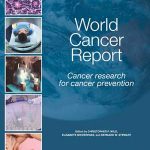Content Overview
 See the table of contents of the new World Cancer Report.
See the table of contents of the new World Cancer Report.
PDF versions of the 2003, 2008, and 2014 World Cancer Reports are available free online.
The new World Cancer Report will have six sections, each containing a number of chapters. An overview of each section is provided here.
Section 1: The global cancer burden
The impact of cancer on the world community is most immediately clear from the number of new cases and mortality. Information currently available presents cancer occurrence in relation to a broad perspective on disease prevention. Beyond this, data from cancer registries in almost all countries enable changes over time (trends) in particular tumour types to be documented. Once recognized, changes in cancer incidence can often be attributed to patterns of human development, and such relationships in turn provide clear opportunities for cancer prevention.
Section 2: Causes of cancer, including hazardous circumstances
The fact that a proportion of most tumour types are caused by particular chemicals, radiation, or biological organisms offers, in most instances, an opportunity for cancer prevention. Some causes of cancer have been known for many decades, although exploitation of this knowledge to prevent cancer has rarely been optimal, particularly from a global perspective. Research findings on cancer causation encompass new insights for both well-recognized carcinogens and those cancer-causing agents that have been recently described. A daunting aspect of research is the extent to which carcinogen exposure – and a consequential burden of disease – that has been controlled in one country or community then emerges in another, even to a greater extent.
Section 3: Biological processes in cancer development
Exposure to a particular carcinogen – or, more commonly, multiple circumstances of exposure – accounts for a proportion of human cancers, acting through different biological pathways at a cellular and molecular level. However, not all people known to be at risk after carcinogen exposure develop cancer. Independently, some people are at greater than average risk of developing cancer because of cancer in earlier generations, but not all members of affected families are afflicted. Finally, cancer may be diagnosed in people not known to have been exposed to relevant carcinogens or whose family has no relevant history. These various scenarios can be explained to varying degrees by biological processes that affect some or all tissues; some of these processes may themselves be the result of environmental or lifestyle exposures. Certain of these processes are described in this section, with particular reference to how available knowledge might be used for prevention.
Section 4: Inequalities affecting cancer prevention
Inequalities, specifically as determined by educational attainment and limitations on circumstances, including nutrition and housing determined by financial income, may perturb the efficacy of virtually all initiatives calculated to reduce the burden of cancer. Relevant factors may be particular to certain countries or regions. Means for investigating such associations, and the manner in which adverse outcomes may be minimized, have improved in recent times. Typically, data are available on variations within a particular country, and certain such data are described in this section.
Section 5: Preventing particular tumour types
The truism that cancer is not a single disease but a multiplicity of different diseases is as valid for cancer prevention as it is for clinical management. Broad understandings about cancer causation, development, detection, and avenues to prevention must be qualified to the extent that no specific list of characteristics (e.g. tumour subtypes) and interventions (e.g. methods of early detection) can be applied with equal relevance to all tumour types. Thus, for example, exogenous causes of prostate cancer are not evident; for now, prevention must focus on sporadic disease or detection of precancerous lesions. For many cancers, there are no recognized screening methods applicable to the whole population. However, success with any research undertaking or preventive measure with one tumour type indicates a means to approach the same challenge for other types.
Section 6: The basis for, and outcomes from, prevention strategies
The burden of death from the multiple different tumour types can be reduced in all communities and countries. The incidence of cancer can be reduced by decreasing or eliminating exposure to carcinogens in multiple contexts. Success in reducing smoking-related cancers in some countries indicates a range of measures that may be researched for efficacy in other situations. Changing behaviour related to nutrition, exercise, and weight gain is being actively researched. Vaccination is effective in relation to some cancers caused by infectious agents. Deaths from sporadic cancer may be reduced through chemoprevention and diagnosis of early disease through screening and emerging molecular methods of early diagnosis. Increased risk of cancer may be indicated by family history and addressed by monitoring affected individuals. The extent to which the options summarized here are realized across national boundaries warrants continuing research.